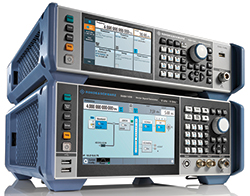
The R&S SMB100B analog RF signal generator and the R&S SMBV100B vector signal generator set new standards in their class, offering unprecedented output power and outstanding spectral purity. The intuitive graphical user interface with a high-resolution touchscreen makes the instruments easy to use. Covering 8 kHz to 1, 3 or 6 GHz and offering various optional performance enhancements, the instruments can be tailored for applications in RF semiconductor development, telecommunications and aerospace and defense.
Output Power Options
Applications such as interference testing or compensation of loss in test setups often require very high output power. This means that a signal generator must be combined with an amplifier connected to its output. The R&S SMB(V)100B offers a better alternative: three different RF output power stages can be chosen to increase the output power. The generators offer a calibrated one-box solution delivering up to +34 dBm output power at 1 GHz without an external amplifier (see Figure 1). This integrated solution simplifies the test setup and eliminates downtime for calibration.
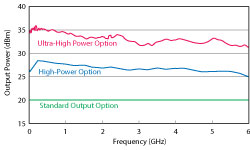
Figure 1 Two options enable the output power of the signal generator to be increased from the basic configuration.
Absolute Level Accuracy
The R&S SMB(V)100B features excellent absolute level accuracy: less than 0.5 dB between 200 kHz and 3 GHz and under 0.7 dB above 3 GHz at levels above -90 dBm, which is best in class. Devices under test (DUT) are rarely connected directly to the generator; cables and other components typically connect the generator to the DUT, which shifts the reference plane from the generator’s RF output to the DUT. Connecting an R&S NRP power sensor to the R&S SMB(V)100B via USB allows extremely precise calibration—to 0.1 dB—at the new reference plane, and the measured power can be read directly from the generator’s display. The RF output power can be adjusted until the desired power at the new reference plane is reached.
Level Repeatability and Linearity
After calibration, it is important for the generator to repeatedly set RF power levels for each test sequence with high precision. Here, the R&S SMB(V)100B delivers top performance with a level repeatability better than 0.02 dB (see Figure 2).
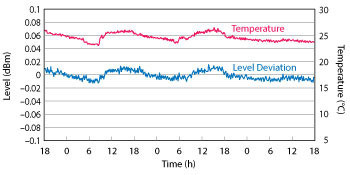
Figure 2 Measured power repeatability over three days, showing the accuracy of the 0 dBm level at 1 GHz. The output was alternated between 0 dBm (shown) and other power levels. The temperature variation vs. time is also shown.
Another critical parameter is level linearity; it is crucial for the generator to keep the deviation from the nominal power level extremely low across a wide amplitude range. Here the generator also excels, with an accuracy of better than 0.2 dB (see Figure 3).
Signal Quality
Single-sideband (SSB) phase noise and wideband noise are key parameters determining signal quality. Not only important in CW applications such as LO substitution, noise plays a significant role in digitally modulated signals, directly influencing the error vector magnitude (EVM). Thanks to its innovative synthesizer design, the R&S SMB(V)100B has very low SSB phase and wideband noise in the standard configuration, making it suitable for generating CW and digitally modulated signals with excellent quality.
The R&S SMB(V)-B1H high performance oven controlled crystal oscillator (OCXO) options further reduce the close-in SSB phase noise (see Figure 4). This makes the R&S SMB(V)100B well-suited for demanding applications that require extremely low SSB phase and wideband noise. Other benefits of this option are significantly improved long-term stability of the reference frequency and greatly reduced temperature dependency.
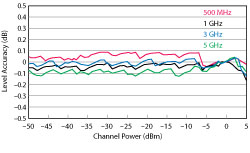
Figure 3 Measured level linearity vs. test frequency, using an internally generated LTE downlink signal.
Wide Modulation Bandwidth
To satisfy the need for broadband signal generation, the R&S SMBV100B is equipped with a high performance baseband with “intelligent” internal real-time frequency response correction, achieving extremely high amplitude flatness—better than 0.1 dB—over the entire RF modulation bandwidth of
500 MHz (see Figure 5).
The R&S SMBV100B combines the large RF modulation bandwidth with the high signal quality, making it excellent for testing and characterizing wideband receivers and multicarrier amplifiers. With EVM less than 0.2 percent for 20 MHz LTE signals and less than 0.4 percent for 160 MHz IEEE 802.11ac signals, the R&S SMBV100B offers far better EVM performance than required for measuring a DUT. This ensures the true performance of the DUT is measured, allowing engineers to focus on the development, without having to worry about the performance of the signal generator.
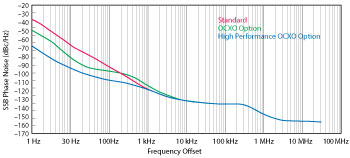
Figure 4 SSB phase noise of the base unit and OCXO options.
A feature unique to the R&S SMBV100B is its excellent EVM performance at high output power levels: less than 0.4 percent for an LTE downlink signal with +18 dBm RMS output power.
Easy Upgrading = Safe Investment
The R&S SMB(V)100B signal generators feature a well-conceived upgrade concept, with options mainly added via software keycodes. Functions such as output power, frequency range and modulation bandwidth (in the case of the R&S SMBV100B) can be upgraded without requiring customers to send the instrument to a Rohde & Schwarz service center. This easy upgrading saves time and money and gives maximum flexibility. It makes the R&S SMB(V)100B signal generators a secure investment, well prepared to meet the needs of tomorrow.
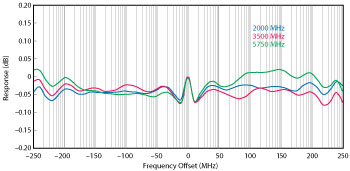 Figure 5 Measured frequency response vs. modulation bandwidth at three carrier frequencies.
Figure 5 Measured frequency response vs. modulation bandwidth at three carrier frequencies.
Rohde & Schwarz
Munich, Germany
